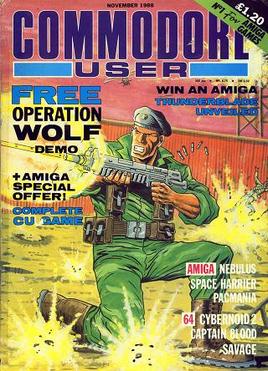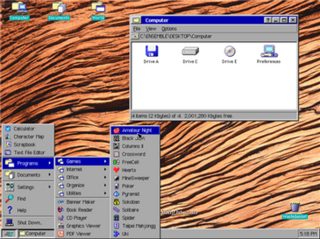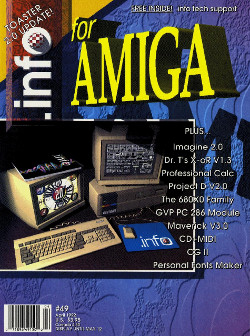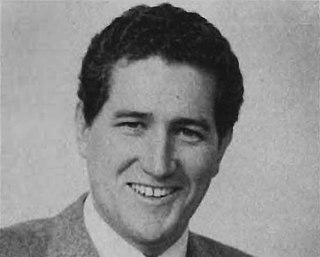
The Commodore 64, also known as the C64, is an 8-bit home computer introduced in January 1982 by Commodore International. It has been listed in the Guinness World Records as the highest-selling single computer model of all time, with independent estimates placing the number sold between 12.5 and 17 million units. Volume production started in early 1982, marketing in August for US$595. Preceded by the VIC-20 and Commodore PET, the C64 took its name from its 64 kilobytes(65,536 bytes) of RAM. With support for multicolor sprites and a custom chip for waveform generation, the C64 could create superior visuals and audio compared to systems without such custom hardware.
Desktop publishing (DTP) is the creation of documents using dedicated software on a personal ("desktop") computer. It was first used almost exclusively for print publications, but now it also assists in the creation of various forms of online content. Desktop publishing software can generate page layouts and produce text and image content comparable to the simpler forms of traditional typography and printing. This technology allows individuals, businesses, and other organizations to self-publish a wide variety of content, from menus to magazines to books, without the expense of commercial printing.

Commodore User, later renamed to CU Amiga, is a series of American and British magazines published by Commodore International.

The Commodore Plus/4 is a home computer released by Commodore International in 1984. The "Plus/4" name refers to the four-application ROM-resident office suite ; it was billed as "the productivity computer with software built in".
The Print Shop is a desktop publishing software package originally published in 1984 by Broderbund. It was unique in that it provided libraries of clip art and templates through a simple interface to build signs, posters and banners with household dot-matrix printers. Over the years, the software has been updated to accommodate changing file formats and printer technologies.

The software program VICE, standing for VersatIle Commodore Emulator, is a free and cross platform emulator for Commodore's 8-bit computers. It runs on Linux, Amiga, Unix, MS-DOS, Win32, macOS, OS/2, RISC OS, QNX, GP2X, Pandora, Dingoo A320, Syllable, and BeOS host machines. VICE is free software, released under the GNU General Public License since 2004.
The Commodore 64 amassed a large software library of nearly 10,000 commercial titles, covering most genres from games to business applications, and many others.

cc65 is a cross development package for 6502 and 65C02 targets, including a macro assembler, a C cross compiler, linker, librarian and several other tools.

GEOS is a computer operating environment, graphical user interface (GUI), and suite of application software. Originally released as PC/GEOS, it runs on MS-DOS-based, IBM PC compatible computers. Versions for some handheld platforms were also released and licensed to some companies.

GEOS is a discontinued operating system from Berkeley Softworks. Originally designed for the Commodore 64 with its version being released in 1986, enhanced versions of GEOS later became available in 1987 for the Commodore 128 and in 1988 for the Apple II. A lesser-known version was also released for the Commodore Plus/4.

The Commodore 64 home computer used various external peripherals. Due to the backwards compatibility of the Commodore 128, most peripherals would also work on that system. There is also some compatibility with the VIC-20 and Commodore PET.

.info was a computer magazine covering Commodore 8-bit computers and later the Amiga. It was published from 1983 to 1992.
Jane is a discontinued GUI-based integrated software package for the Apple II, Commodore 64 and Commodore 128 personal computers. It was developed by Arktronics in 1984,
The Commodore 1351 is a computer mouse made by Commodore in 1986, which can be directly plugged into the 9-pin control port of a Commodore 64 or 128.

Scene World Magazine is a disk magazine for the Commodore 64 home computer. The magazine has been released regularly since February 2001.

Magic Desk was a planned series of productivity software by Commodore Business Machines for the Commodore 64. Only the first entry, Type and File, was ever released. It was introduced at the summer edition of the 1983 Consumer Electronics Show in June, slated for an August 31 release. Commodore developed the Magic Desk suite both in response to a perceived lack of productivity software for the Commodore 64 and to the graphical user interface of the Apple Lisa.

Brian P. Dougherty is an American software developer and businessman best known as the founder and CEO of Berkeley Softworks, which produced the pioneering GEOS graphical operating system for the Commodore 64 in 1986 and the influential PC/GEOS operating system for the IBM PCs and compatibles in 1990. Dougherty also founded GlobalPC, Airset and Wink Communications. While Dougherty was CEO of GeoWorks, he had been approached by several large technology companies including Microsoft and Apple because of the success of the GEOS operating system. Dougherty attended the University of California, Berkeley, where he graduated with a B.S. in electrical engineering and computer science. When he graduated he began working at Mattel, where he contributed for the design of the Intellivision video game system.

Berkeley Softworks, Inc., later GeoWorks Corporation, was an American software-development company founded by American computing engineer and former Mattel employee Brian P. Dougherty in 1983. It is best known for its GEOS operating systems for GEOS for the Commodore 64, 64c, plus 4, Apple II and the c128 and PC/GEOS, also known as GeoWorks ensemble or simply GeoWorks. The company ceased operations in 2003 after it was bought by various other companies.












